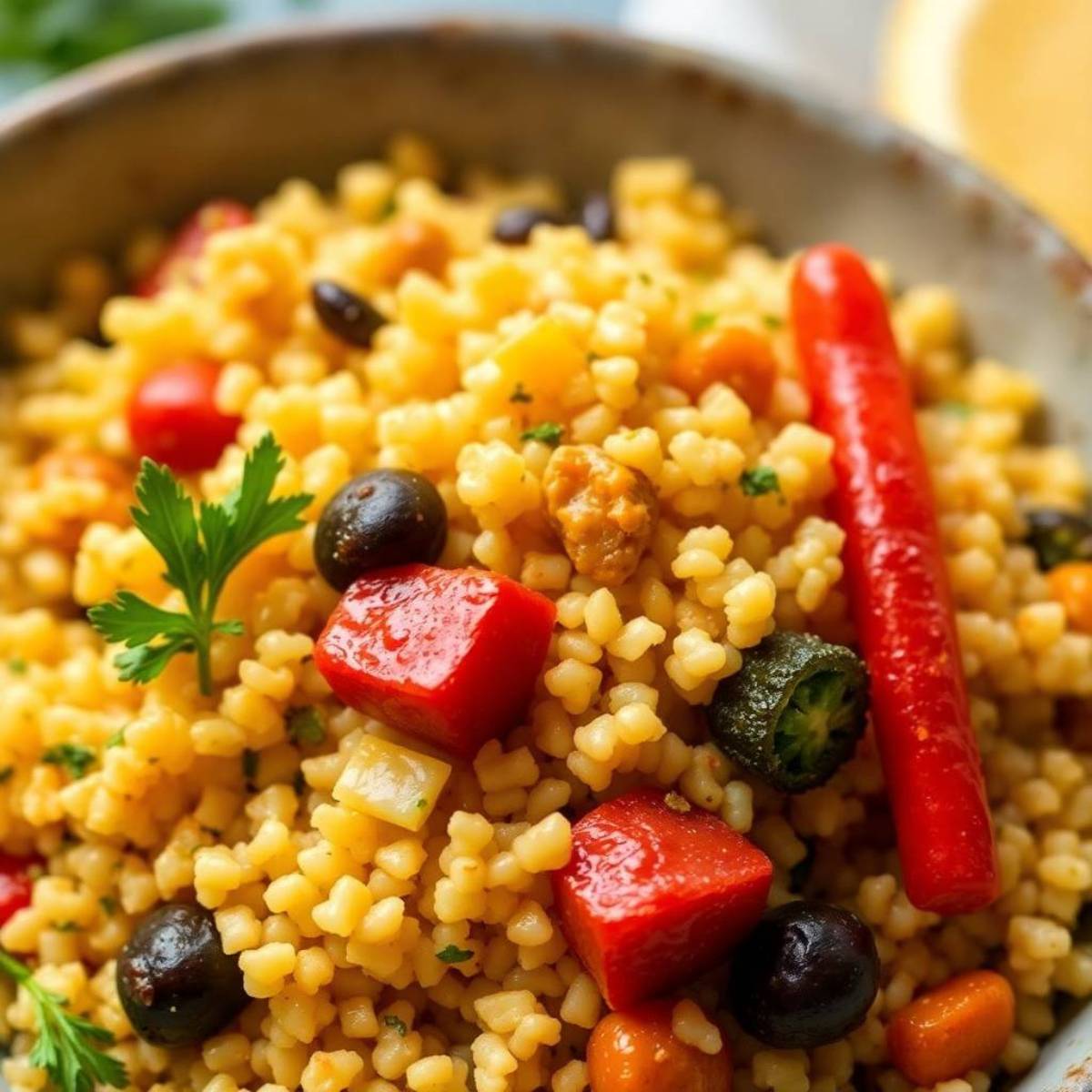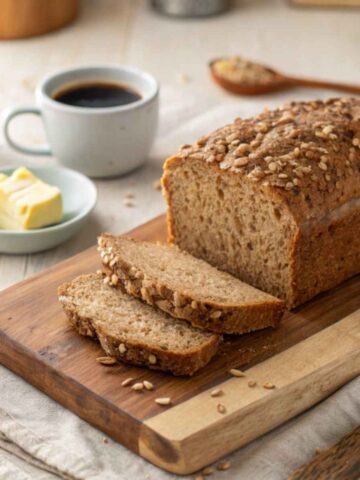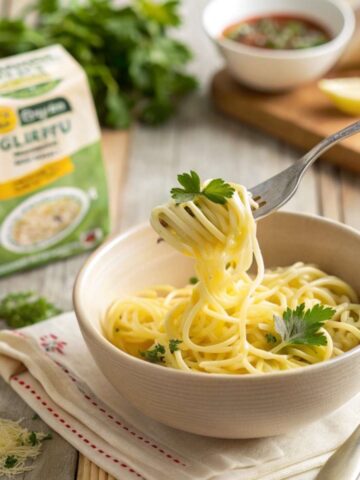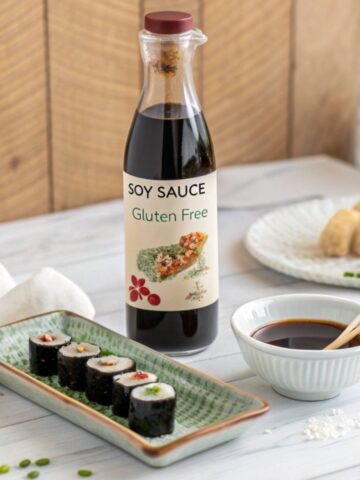Couscous is a popular worldwide dish, especially in North African and Mediterranean cuisines. It’s often seen as a versatile side dish or the base for salads and stews. However, if you’re following a gluten-free diet, you might wonder: Is couscous gluten-free? In this article, we’ll dive into the details of couscous, its ingredients, and how to find gf alternatives so you can make informed choices while sticking to your gf lifestyle.

Jump to:
What is Couscous?
Couscous is a type of pasta made from tiny granules of semolina wheat. It’s traditionally steamed and served with meat, vegetables, or sauces. Semolina, a coarsely ground form of durum wheat, is the crucial ingredient in most traditional couscous, making it not gluten-free. This is because semolina is derived from wheat, which contains gluten. This protein can trigger adverse reactions in people with celiac disease or gluten sensitivity.
Is Couscous Naturally Gluten-Free?
No, traditional couscous is not gluten-free because manufacturers use wheat to make it. Furthermore, since wheat, barley, and rye primarily contain gluten, couscous naturally contains gluten due to its wheat-based composition. This means that people with celiac disease or non-celiac gluten sensitivity should avoid regular couscous unless they can find gf alternatives.
Gluten-Free Couscous Alternatives
While traditional couscous is not gf, several alternatives mimic its texture and versatility. Moreover, they are safe for those avoiding gluten. Here are some of the best options:
1. Quinoa
Quinoa is a naturally gf seed that, when cooked, resembles couscous in texture. Moreover, quinoa packs a high amount of protein and fiber, making it a nutritious substitute for couscous in salads, bowls, and side dishes. Quinoa is versatile and absorbs flavors well, much like couscous.
2. Millet
Millet, a small gf grain, serves as an excellent alternative to couscous. When cooked, it offers a light, fluffy texture similar to couscous. Additionally, it is rich in vitamins and minerals like magnesium and phosphorus, making it a nutritious choice. Millet is also easy to cook and pairs well with a variety of flavors.
3. Gluten-Free Couscous Brands
Some manufacturers produce gluten-free couscous from alternative grains such as corn or rice. Manufacturers design these products for people who want to avoid gluten but still enjoy a couscous-like dish. Brands such as Bob’s Red Mill offer gf couscous alternatives that are safe for those with gluten sensitivity.
4. Cauliflower Couscous
Cauliflower couscous serves as an excellent low-carb and gluten-free alternative. By grating or processing cauliflower into small, couscous-sized pieces and lightly cooking it, this option provides a texture similar to regular couscous. Additionally, you can enhance its flavor with spices, herbs, or sauces, making it just as versatile and delicious.
How to Cook Gluten-Free Couscous Alternatives
Furthermore, whether you use quinoa, millet, or gf couscous, cooking is simple and quick. Here’s an essential guide to preparing some of the most popular gf couscous alternatives:
Quinoa:
- Rinse 1 cup of quinoa under cold water to remove any bitterness.
- Combine with 2 cups of water or broth in a pot.
- Bring to a boil, then reduce to a simmer.
- Cook for 15 minutes or until the water is absorbed.
- Fluff with a fork and serve.
Millet:
- Toast 1 cup of millet in a dry skillet until fragrant.
- Add 2 cups of water or broth.
- Bring to a boil, then reduce heat to low and cover.
- Cook for 20 minutes or until the liquid is absorbed.
- Fluff and serve as you would with couscous.
Cross-Contamination Concerns
Even small amounts of gluten can cause problems for people with celiac disease, so avoiding cross-contamination is crucial. Always check for gluten-free certifications on the packaging when purchasing gf couscous alternatives. Manufacturers test certified gluten-free products and produce them in facilities that actively prevent cross-contamination with gluten-containing grains.
Additionally, if you prepare gf couscous in a kitchen that also handles regular couscous, use separate utensils, cookware, and serving tools to prevent gluten exposure.
Gluten-Free Couscous Recipes
There are countless delicious ways to enjoy gluten-free couscous alternatives. Moreover, here are a couple of easy and flavorful ideas to inspire your next meal:
Gluten-Free Quinoa Salad
Ingredients:
- 1 cup cooked quinoa
- 1/2 cup diced cucumbers
- 1/2 cup cherry tomatoes, halved
- 1/4 cup red onion, chopped
- 1/4 cup feta cheese (optional)
- Two tablespoons of olive oil
- One tablespoon of lemon juice
- Salt and pepper to taste
Instructions:
- Combine the cooked quinoa, cucumbers, tomatoes, red onion, and feta in a large bowl.
- Whisk together the olive oil, lemon juice, salt, and pepper in a small bowl.
- Pour the dressing over the quinoa salad and toss to combine. Serve chilled or at room temperature.
Millet Couscous with Roasted Vegetables
Ingredients:
- 1 cup cooked millet
- One zucchini, diced
- One bell pepper, diced
- One red onion, sliced
- One tablespoon of olive oil
- Salt, pepper, and herbs to taste
Instructions:
- Preheat the oven to 400°F (200°C).
- Toss the zucchini, bell pepper, and onion with olive oil, salt, pepper, and herbs.
- Spread the vegetables on a baking sheet and roast for 20 minutes, until tender.
- Mix the roasted vegetables with the cooked millet and serve as a warm side dish.
Conclusion
While traditional couscous is not gf due to its wheat content, plenty of gf alternatives offer a similar texture and flavor. Quinoa, millet, and gluten-free couscous products allow you to enjoy all the versatility of couscous without worrying about gluten exposure. Whether making a hearty salad or a comforting side dish, these gluten-free options provide delicious alternatives for any meal.
FAQs
No, manufacturers make traditional couscous from wheat, which contains gluten. However, gf alternatives include quinoa, millet, and specially-made gf couscous products.
Quinoa and millet are two of the best gf substitutes for couscous. Moreover, they offer similar textures and work well in a variety of recipes.
Yes, some brands produce gf couscous made from corn or rice. Additionally, always check the packaging for gf certification to ensure it is safe for individuals with gluten sensitivities.
Yes, cauliflower couscous is naturally gf. Producers create it by grating or processing cauliflower into small, couscous-like pieces, making it an excellent low-carb and gf option.
Yes, quinoa is an excellent gf alternative to couscous. It has a similar texture and absorbs flavors well, making it a versatile ingredient in salads, bowls, and side dishes.

Gluten-Free Quinoa Salad Recipe
- Total Time: 23 minutes
- Yield: 4 Servings 1x
Description
This refreshing and versatile Gluten-Free Quinoa Salad is perfect for a light lunch, side dish, or main course. Made with naturally gluten-free quinoa, fresh vegetables, and a tangy lemon dressing, it's a healthy and delicious alternative to traditional couscous salads
Ingredients
- 1 cup cooked quinoa
- 1/2 cup diced cucumbers
- 1/2 cup cherry tomatoes (halved)
- 1/4 cup red onion (chopped)
- 1/4 cup feta cheese (optional)
- Two tablespoons olive oil
- One tablespoon lemon juice
- Salt and pepper to taste
Instructions
- In a large bowl, combine the cooked quinoa, cucumbers, tomatoes, red onion, and feta cheese (if using).
- Whisk the olive oil, lemon juice, salt, and pepper in a small bowl.
- Pour the dressing over the quinoa mixture and toss to combine.
- Serve chilled or at room temperature. Enjoy as a gluten-free side dish or light main course.
Notes
Add your favorite vegetables, nuts, or seeds to customize this salad. For a vegan option, simply omit the feta cheese. This salad stores well in the fridge for up to two days.
- Prep Time: 10 minutes
- Cook Time: 13 minutes
- Category: Salad, Side Dish
- Cuisine: gluten-free, Mediterranean
Nutrition
- Calories: 220
Keywords: gluten free Quinoa Salad, gluten-free salad, gluten-free side dish, quinoa





Leave a Reply